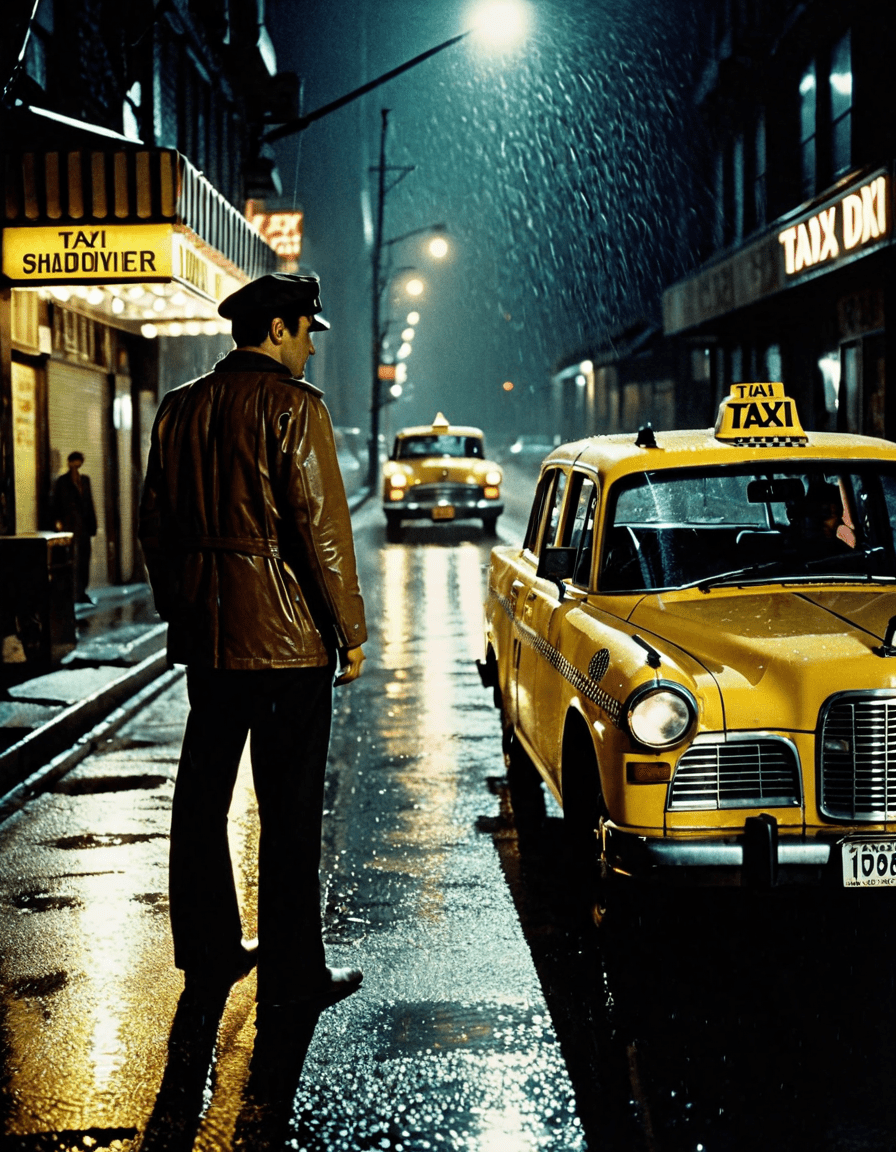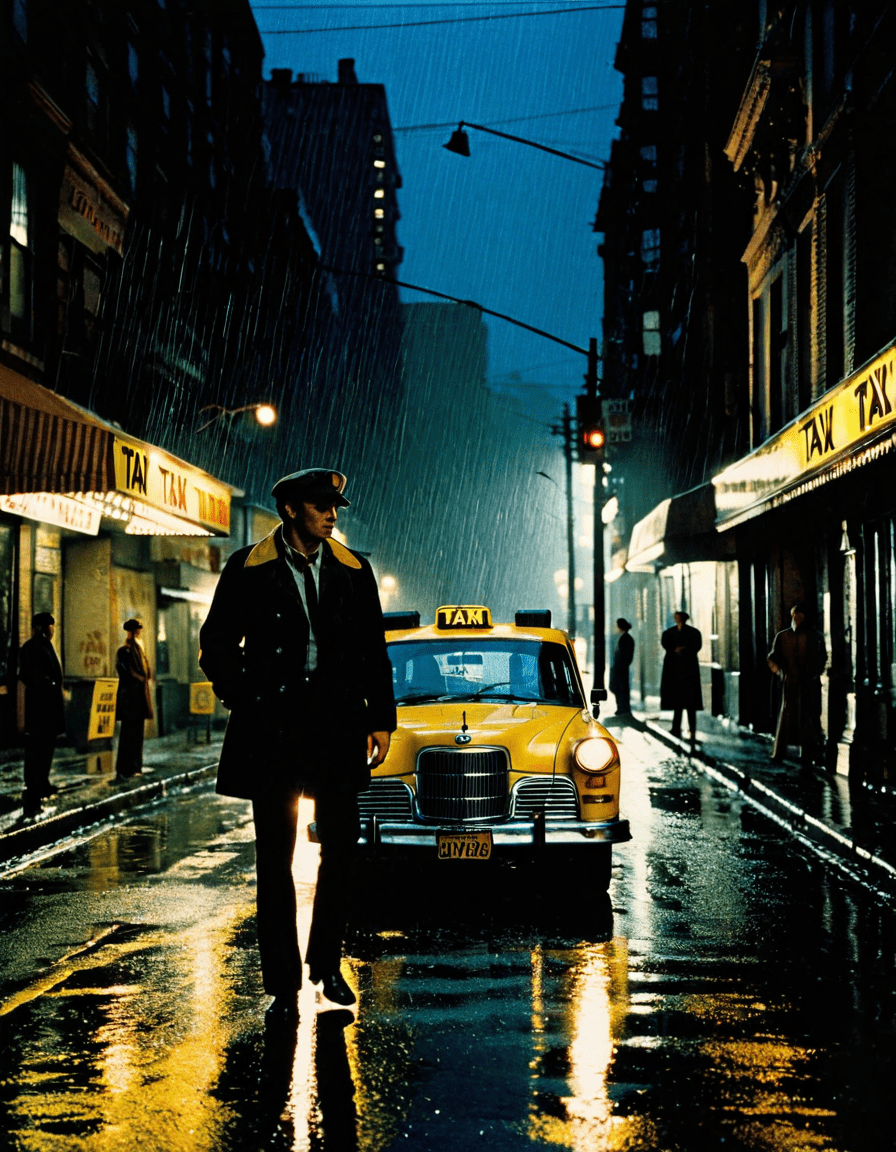Martin Scorsese’s 1976 film, Taxi Driver, stands as a seminal work in American cinema, creating a vivid depiction of the gritty, urban darkness that lurks beneath the surface of New York City. With its haunting portrayal of alienation and madness, this film captures the essence of a tumultuous era in American culture that resonates even today. As we dive into the elements that contribute to the film’s lasting impact, we’ll discuss how it mirrors contemporary society, connect it to other pop culture phenomena, and examine its significant techniques that amplify its narrative.

1. The Evolution of Anti-Heroes: Examining Travis Bickle and Kojak
In the soul of Taxi Driver, we meet Travis Bickle, a character who’s as complex and layered as a New York City skyline. Robert De Niro’s portrayal of this Vietnam veteran teeters on the edge of sanity, channeling a man grappling with post-war disillusionment and societal neglect. Bickle showcases the evolution of the anti-hero, contrasting sharply with Kojak, the suave and charismatic detective from the 1970s series starring Telly Savalas. While Kojak represents a grounded character with a robust moral compass, Bickle spirals into a world of personal vendetta, questioning the very fabric of justice.
This stark differentiation molds the anti-hero arChetype from a champion of justice into a vengeful figure, capturing the transformation and confusion of 1970s America.

2. Cultural Reflections: How Taxi Driver Mirrors American Society
The film isn’t just a story; it’s a vivid canvas that reflects the struggles of 1970s America. During this period, notable incidents like the shocking crimes of the BTK Killer fueled public paranoia, mirroring the chaos depicted in Taxi Driver. Scorsese expertly juxtaposes the feelings of mistrust and discontent that permeated society, echoing the ugly truths of a nation grappling with crime, disillusionment, and fading innocence.
By framing Bickle’s descent into madness against a backdrop of societal decay, Scorsese provides much more than entertainment; he offers a profound commentary on the human condition and the moral dilemmas of an entire generation.
3. Cinematic Techniques: The Use of Urban Landscapes to Amplify Themes
Visually, Taxi Driver can be seen as a pulse of urban New York City, where the streets are more than just a setting; they’re a character in their own right. Scorsese’s cinematic tricks, from atmospheric shots to tight framing, create a sense of claustrophobia that mirrors Travis’s psychological entrapment. The film’s cinematography often syncs with today’s animated features like Brother Bear, which, while stylistically different, also delves into themes of belonging and introspection.
The atmosphere crafted by Scorsese elevates Taxi Driver from mere film to an immersive experience, drawing viewers into the chaotic mind of Travis Bickle and the grim streets he roams.
4. Lasting Impact and Relevance: From Taxi Driver to Modern Narratives
Forty-six years since its release, Taxi Driver still casts a long shadow over modern cinema, influencing a slew of films and series that echo its themes of existential dread. The concept of the urban anti-hero battling personal demons has proliferated across a myriad of storytelling mediums, demonstrating how Scorsese’s capital work shaped contemporary narratives.
In a rapidly changing world, the themes found in Taxi Driver remain cutting-edge, Triggering discussions relevant to our present societal landscape, including moral ambiguity and the rawness of human emotion. Through Scorsese’s brilliant storytelling, Taxi Driver isn’t just a classic; it’s a cultural artifact that continues to provoke thought about the dark streets we all navigate in our minds and societies.
Urban Dark Desires: The Lasting Influence of Taxi Driver
In the grand tapestry of American cinema, Taxi Driver remains a potent reflection of society’s fears and challenges. It captures the complexity of the human condition amidst ongoing urban struggles, allowing us to confront our perceptions and the psychological battles we silently endure. Scorsese crafted more than a film; he created a touchstone that resonates through the ages, revealing the darker aspects of both humanity and our urban environments.
This exploration of Taxi Driver infuses the cinematic brilliance and thematic depth into the conversation, ensuring its place not only in film history but also as a mirror for contemporary society grappling with an enduring urban darkness. So the next time you find yourself pondering life’s complexities, take a moment to reflect on the gritty essence of Taxi Driver. It teaches that while the city may feel dark, the stories we tell can shine a light on our innermost fears and hopes.
For those seeking the best streaming Movies right now, don’t forget to check out avenues like Perez Art museum. Whether delving into the nuances of character arcs or pondering themes of isolation, Taxi Driver serves as both a masterpiece and a discussion starter, making it a must-watch for any cinema aficionado.
Taxi Driver 1976: Fascinating Trivia and Fun Facts
Behind the Scenes Secrets
Taxi Driver 1976″ remains a masterpiece tapping into the gritty depths of urban life, and its production carries some intriguing tidbits. Did you know that Martin Scorsese’s iconic film was initially inspired by the big e phenomenon, which reflects the darker sides of the human condition? Scorsese, teamed up with Paul Schrader’s raw script, created a narrative that digs deep into loneliness and alienation. And speaking of edges, the now-cult classic famously features Robert De Niro’s haunting line,You talkin’ to me? which was largely improvised! Ironically, this line resonates with an accidental cum effect—often impacting viewers in unexpected ways.
Cultural Impact and Reception
When “Taxi Driver 1976” premiered, its reception was as polarized as Travis Bickle’s psyChe. Critics praised its depiction of a city spiraling into chaos. Over the years, the film has become a cultural touchstone, referenced everywhere from memes to highbrow discussions about urban decay. Imagine a world without its classic imagery; we might’ve missed out on iconic references that have seeped into our everyday speak. That connection to culture is akin to the nostalgia many felt for the Atari era in gaming—both showcase their times’ raw, gritty realities.
A Legacy for Generations
The legacy of “Taxi Driver 1976” continues to influence filmmakers and audiences alike. It’s surprising how this film remains a critical reference point in pop culture and academia. Researchers even link its themes to modern issues, compelling speakers in Keynote speaker marketing to explore its relevance in contemporary society. In fact, understanding Bickle’s tumultuous journey may help us unpack today’s challenges, much like seeking clarity in Myuah. It’s fascinating how this film connects past and present, revealing layers of significance that keep us engaged—in the end,Taxi Driver 1976″ isn’t just a film; it’s a mirror reflecting the intricacies of human experience.





